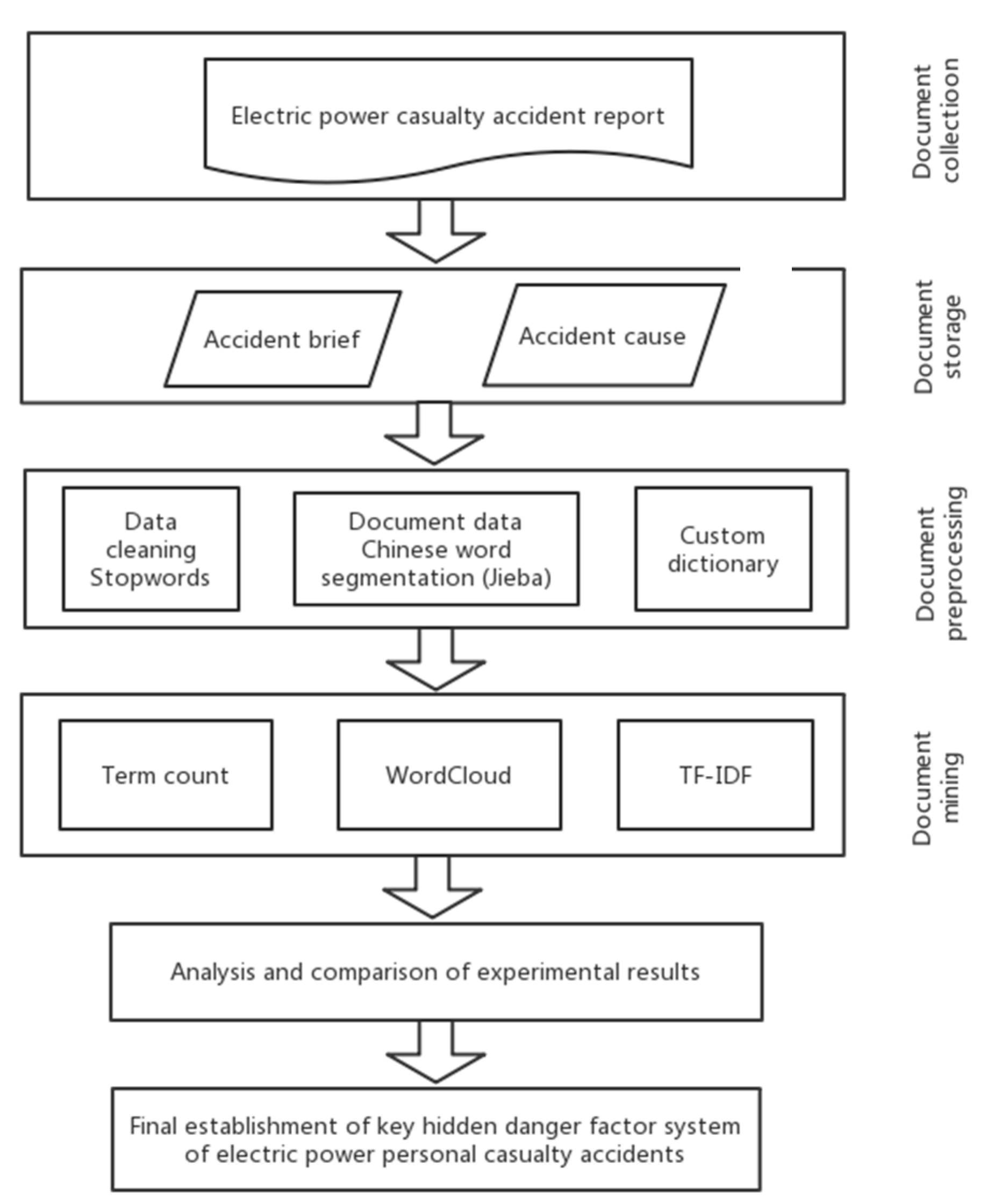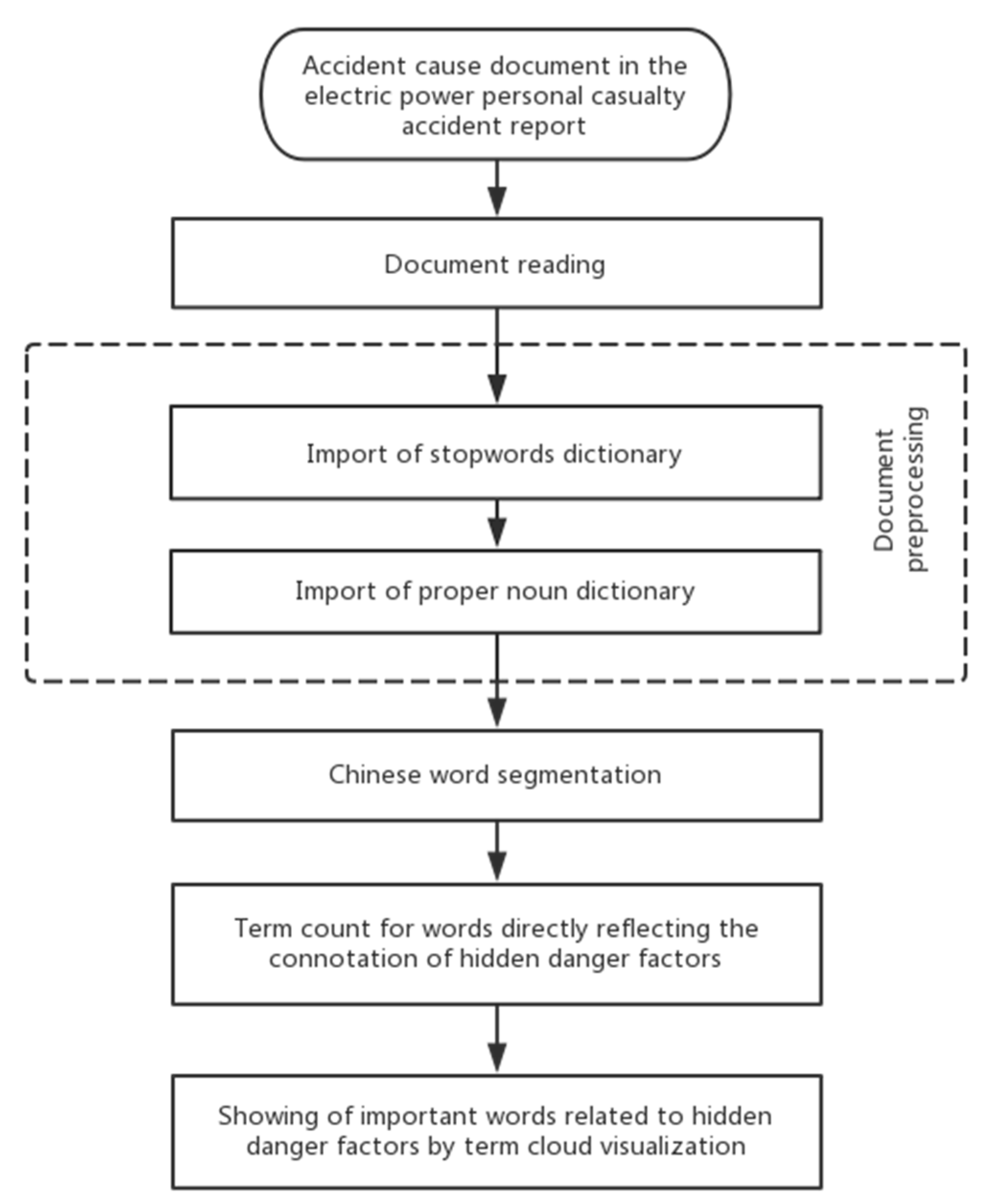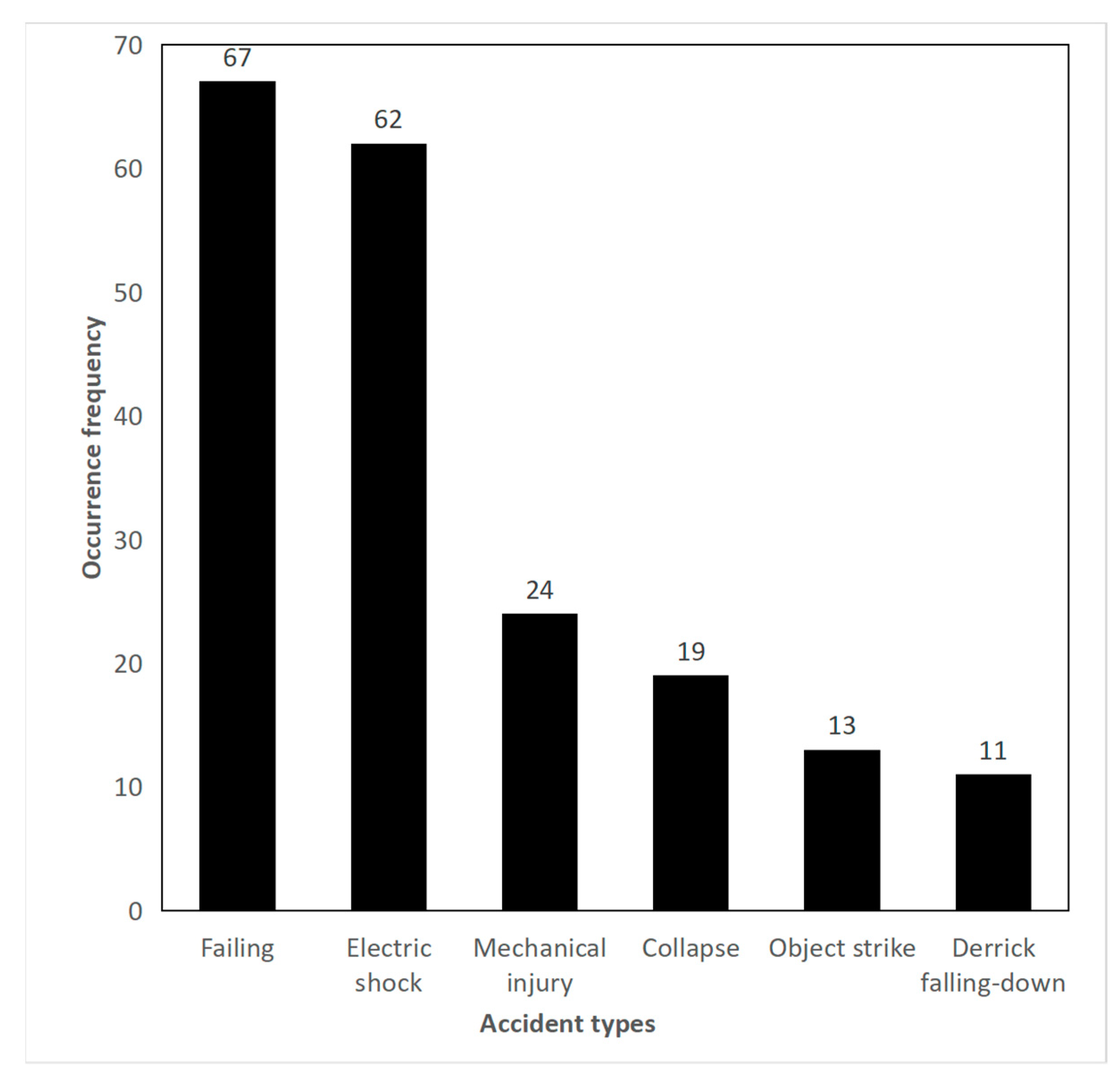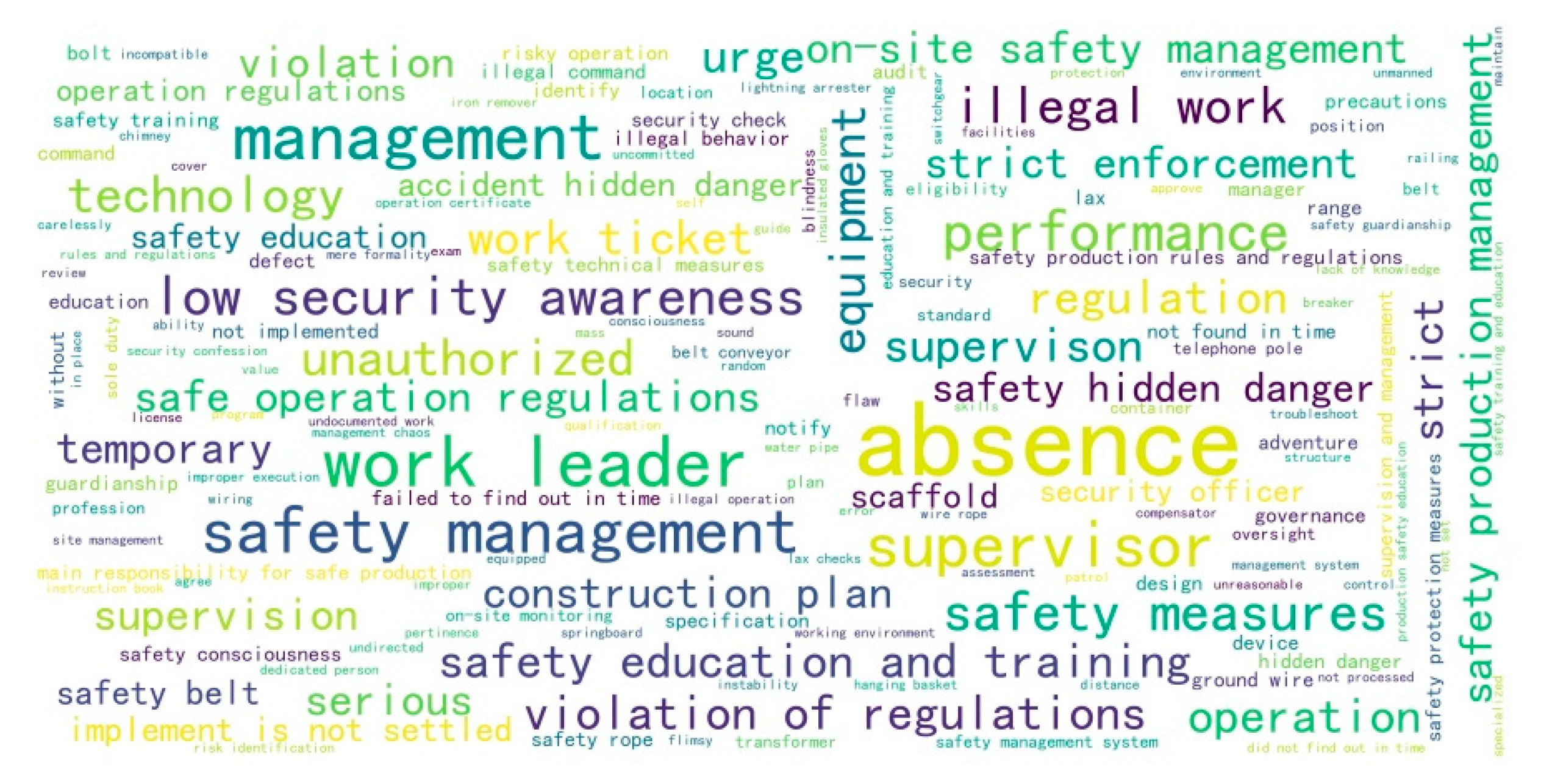Establishment of a Key Hidden Danger Factor System for Electric Power Personal Casualty Accidents Based on Text Mining
Abstract
1. Introduction
- (1)
- The hidden danger factors of electric power personal injury accidents are preliminarily determined through literature research and based on the definitions of the three types of hazard sources, by removing the factors that cannot be eliminated by management means.
- (2)
- This study develops a text mining approach for the development of a hidden danger factor system for electric power personal injury accidents, and it picks the essential hidden danger factors based on absolute and relative word frequency. We employ the average maximum TF-IDF value of hidden danger factor proper phrases associated with hidden danger factors as one of the assessment indices during the process.
2. Related Works
2.1. Research on the Extraction of Influencing Factors of Power Accidents
2.2. Research on Identifying Accident-Influencing Factors Based on Text Mining
3. Preliminary Establishment of Hidden Danger Factor Index System of Electric Power Personal Casualty Accidents
3.1. Analysis on Influencing Factors of Electric Power Personal Casualty Accidents
3.2. Preliminary Identification of Hidden Danger Factors of Electric Power Personal Casualty Accidents
4. Extraction Method of Key Hidden Danger Factors of Electric Power Personal Casualty Accidents Based on Document Mining
4.1. Experimental Scheme of Document File
4.2. Document Preprocessing
- Due to the redundancy, incompleteness, and complexity of a huge quantity of document data in the electric power personal casualty accident report, it is required to pre-process the content first to increase the effect of document mining [40], which mostly includes Stopword’s filtration. In the original accident report document, there are numerous punctuation marks such as “,”, “.”, and “...”, as well as meaningless phrases for experimental purposes such as “of”, “very”, “limited company”, and “power supply station” that should be removed. As a result, in order to filter the document content, a stop list must first be specified.
- Segmentation of Chinese words: some specific words hidden in the whole language in the electric power personal casualty accident report express the precise connotation of the important concealed danger aspects of electric power personal casualty accident. For example, “XiaoX Li, an untrained masonry worker, has weak self-protection awareness and inadequate safety knowledge”. It reflects that the accident is related to the work skill level/knowledge level/ability and quality in personnel hidden threats. As a result, word segmentation for the document content using Chinese word segmentation is required, as well as word segmentation for each concealed risk factor’s connected terms, in order to prepare for its following characteristic calculation and reduction.
- Create your own dictionary: Chinese sentences are made up of meaningful genuine words and function words that help create the sentence grammar; because there is no space between words, Chinese sentences cannot be subdivided directly by spaces and punctuation between words as English sentences can. As a result, a dictionary or an algorithm is often needed to finish the word segmentation [40]. Jieba, a Python-based word segmentation tool, is utilized in this work to finish the word segmentation of an electric power personal casualty accident report document. A custom dictionary was imported to realize the fixed collocation and combination of words related to various hidden danger factors in order to ensure the accuracy and completeness of the word segmentation results related to various hidden danger factors and avoid the segmentation of proper nouns such as “...... weak/self/protection/consciousness, poor/safety/consciousness”, “self-protection awareness”, and “safety awareness” to guarantee that the follow-up trial runs well.
4.3. Word Cloud Building
4.4. Term Frequency Counting
5. Analysis on Document Mining Results of Electric Power Personal Casualty Accident Report
5.1. Data Sources
5.2. Document Mining of Accident Brief
5.3. Document Mining of Accident Causes
5.3.1. Word Cloud of Accident Hidden Danger Factors
5.3.2. Screening Results and Analysis of Key Hidden Danger Factors Based on Term Count and TF-IDF
6. Establishment of Key Hidden Danger Factor System of Electric Power Personal Casualty Accidents Based on Empirical Analysis
7. Conclusions
Author Contributions
Funding
Conflicts of Interest
References
- State Council of the PRC. Report on Production Safety Accident and Regulations of Investigation and Treatment. 28 March 2007. Available online: http://www.gov.cn/zwgk/2007-04/19/content_588577.htm (accessed on 4 June 2020).
- Electric Power Safety Supervision Department of National Energy Administration. Compilation of National Power Accidents and Power Security Incidents (2014); China Power Media Group Co., Ltd.: Beijing, China, 2015. [Google Scholar]
- Tian, S.C. Study on Identification and Control of the Third Type of Hazard; Beijing Institute of Technology: Beijing, China, 2001. [Google Scholar]
- State Administration of Work Safety. Interim Provisions on the Investigation and Control of Safety Accidents. 28 December 2007. Available online: https://www.mem.gov.cn/fw/flfgbz/gz/200801/t20080110_233408.shtml (accessed on 4 June 2020).
- Williamson, A.; Feyer, A.M. The causes of electrical fatalities at work. J. Saf. Res. 1998, 29, 187–196. [Google Scholar] [CrossRef]
- Zhao, D.; Thabet, W.; McCoy, A.; Kleiner, B. Electrical deaths in the US construction: An analysis of fatality investigations. Int. J. Inj. Control. Saf. Promot. 2014, 21, 278–288. [Google Scholar] [CrossRef]
- Chi, C.F.; Yang, C.C.; Chen, Z.L. In-depth accident analysis of electrical fatalities in the construction industry. Int. J. Ind. Ergon. 2009, 39, 635–644. [Google Scholar] [CrossRef]
- Wei, X.N.; Liu, Y.G.; Huang, Y.L.; Chen, G.S.; Xiao, J.H. Prediction on human casualty hazard in power-supplying operation based on multiple linear regression. J. Saf. Sci. Technol. 2015, 11, 178–184. [Google Scholar]
- Sun, H.L. Study on Risk Management of the Electric Power Enterprise Production Safety; Qingdao University of Technology: Shandong, China, 2018. [Google Scholar]
- Li, J.; Wang, J.P.; Xu, N.; Zhou, Z. Analysis of safety risk factors for metro construction based on text mining method. Tunn. Constr. 2017, 2, 33–42. [Google Scholar]
- Wu, J.; Jiang, F.C. An analysis and risk forecasting of inland ship collision based on text mining. J. Transp. Inf. Saf. 2018, 3, 154–161. [Google Scholar]
- Tan, Z.L.; Chen, X.; Song, Q.Z.; Chen, X.C. Analysis for the potential hazardous risks of the coal mines based on the so-called text mining. J. Saf. Environ. 2017, 4, 1262–1266. [Google Scholar]
- Feng, J.; Gong, C.; Li, X.; Lau, R.Y. Automatic approach of sentiment lexicon generation for mobile shopping reviews. Wirel. Commun. Mob. Comput. 2018, 10, 232–240. [Google Scholar] [CrossRef]
- Castillo-rosa, J.; Suarez-cebador, M.; Rubio-romero, J.C.; Aguado, J.A. Personal factors and consequences of electrical occupational accidents in the primary, secondary and tertiary sectors. Saf. Sci. 2017, 91, 286–297. [Google Scholar] [CrossRef]
- Cheng, C.W.; Leu, S.S.; Lin, C.C.; Fan, C. Characteristic analysis of occupational accidents at small construction enterprises. Saf. Sci. 2010, 48, 698–707. [Google Scholar] [CrossRef]
- Dokov, W. Assessment of risk factors for death in electrical injury. Burns 2009, 35, 114–117. [Google Scholar] [CrossRef]
- Yang, Y.Q. Evaluation Model of Power Operation of Personal Risk Quantification; South China University of Technology: Guangdong, China, 2015. [Google Scholar]
- Suarez-cebador, M.; Rubio-romero, J.C.; Lopez-arquillos, A. Severity of electrical accidents in the construction industry in Spain. J. Saf. Res. 2014, 48, 63–70. [Google Scholar] [CrossRef] [PubMed]
- Khanzode, V.V.; Maiti, J.; Ray, P.K. Occupational injury and accident research: A comprehensive review. Saf. Sci. 2012, 50, 1355–1367. [Google Scholar] [CrossRef]
- Paivinen, M. Electricians’ perception of work-related risks in cold climate when working on high places. Int. J. Ind. Ergon. 2006, 36, 661–670. [Google Scholar] [CrossRef]
- Tang, J.X. Research on Human Reliability Analysis and Accident Pre-control of Power Grid; Zhejiang University: Zhejiang, China, 2015. [Google Scholar]
- Zhang, J.W. Research on Human Error of Power Accidents Based on HFACS; Soochow University: Jiangsu, China, 2016. [Google Scholar]
- Ren, C.Y. Application on Safety Management of Human Factors Engineering Theory in Electric Power Company; Tianjin University: Tianjin, China, 2016. [Google Scholar]
- Wu, S.S. Research and Application on safety Human Factors in Electricity Enterprises; Beijing Jiaotong University: Beijing, China, 2013. [Google Scholar]
- Wu, S.P. Study on the Influencing Factors and Management of Human Errors in the Production of Electricity Enterprises; Beijing Jiaotong University: Beijing, China, 2009. [Google Scholar]
- Yang, Z.L. Electric Power Production Safety Risk Causes and Pre-Control Method Research; North China Electric Power University: Beijing, China, 2016. [Google Scholar]
- Ye, J.G. Safety Risk Identification and Control. System of Power Supply Enterprise; North China Electric Power University: Beijing, China, 2014. [Google Scholar]
- Mellen, P.F.; Weedn, V.W.; Kao, G. Electrocution: A review of 155 cases with emphasis on human factors. J. Forensic Sci. 1992, 37, 1016–1022. [Google Scholar] [CrossRef]
- Zhu, L.N. Research on the Early Warning of Production Safety Accidents in Power Generation Enterprises Based on Bayesian Network; North China Electric Power University: Beijing, China, 2019. [Google Scholar]
- Editorial board of “Construction and Practice of Intrinsic Safety Capability of Power Grid Enterprises”. Construction and Practice of Intrinsic Safety Capability of Power Grid Enterprises; China Electric Power Press: Beijing, China, 2018. [Google Scholar]
- Shen, Y.L.; Yang, Z.X.; Li, H.L.; Zhang, K.; Liu, Y.Z. A review of the safety psychology and physiology related research in electric power human accident. Telecom World 2019, 26, 368–369. [Google Scholar]
- Li, Y.B.; Han, Y.; Zhang, R.; Li, Y. Research on impact model of meteorological factors on the power accidents. Power Syst. Technol. 2013, 37, 1683–1687. [Google Scholar]
- Yu, X.; Xu, C.; Lu, D.; Zhu, Z.; Zhou, Z.; Ye, N.; Mi, C. Design and application of a case analysis system for handling power grid operational accidents based on case-based reasoning. Information 2020, 11, 91. [Google Scholar] [CrossRef]
- Yang, Y.J.; Yuan, H.H.; Wang, Y.L. Sentiment analysis method for comment text. J. Nanjing Univ. Sci. Technol. 2019, 43, 280–285. [Google Scholar]
- Tan, J.Y.; Ma, S.C. Research on network microblogging lyrics topic recognition and tracking technology based on clustering. J. Chongqing Univ. Technol. 2019, 33, 176–181. [Google Scholar]
- Electric Power Safety Supervision Department of National Energy Administration. Compilation of National Power Accidents and Power Security Incidents (2015); China Power Media Group Co., Ltd.: Beijing, China, 2016. [Google Scholar]
- Electric Power Safety Supervision Department of National Energy Administration. Compilation of National Power Accidents and Power Security Incidents (2016); China Power Media Group Co., Ltd.: Beijing, China, 2017. [Google Scholar]
- Electric Power Safety Supervision Department of National Energy Administration. Compilation of National Power Accidents and Power Security Incidents (2017); China Power Media Group Co., Ltd.: Beijing, China, 2018. [Google Scholar]
- Electric Power Safety Supervision Department of National Energy Administration. Compilation of National Power Accidents and Power Security Incidents (2019); China Power Media Group Co., Ltd.: Beijing, China, 2019. [Google Scholar]
- Huang, C.N.; Zhao, H. Chinese word segmentation: A decade review. J. Chin. Inf. Process. 2007, 3, 8–19. [Google Scholar]
- Yang, B.; Han, Q.W.; Lei, M.; Zhang, Y.P.; Liu, X.G.; Yang, Y.Q.; Ma, X.F. Short text classification algorithm based on improved TF-IDF weight. J. Chongqing Univ. Technol. 2016, 30, 108–113. [Google Scholar]
- Zhang, J. A Method of intelligence key words extraction based on improved TF-IDF. J. Intell. 2014, 33, 153–155. [Google Scholar]




| Factor Category | No. | Specific Causes and Influencing Factors of Accidents | Mentioned Paper | Quantity of Mentioned Paper |
|---|---|---|---|---|
| Personnel factor | 1 | Gender | Literature [6,7,14,15,16] | 5 |
| 2 | Nationality | Literature [14] | 1 | |
| 3 | Age | Literature [6,7,8,14,15,16,17,18,19,20] | 10 | |
| 4 | Education background/education level/intelligence level | Literature [15,19,21,22] | 4 | |
| 5 | Working years/work experience level/familiarity/qualifications | Literature [7,8,14,15,17,18,19,20,21,23] | 10 | |
| 6 | Time for current work | Literature [20] | 1 | |
| 7 | Contract type | Literature [15] | 1 | |
| 8 | Work skill level/knowledge level/ability and quality | Literature [7,8,9,15,17,19,21,22,23,24,25,26,27,28] | 15 | |
| 9 | Working habit | Literature [5,6,7,8,9,15,17,19,21,22,26,27,28,29,30] | 16 | |
| 10 | Absenteeism | Literature [19] | 1 | |
| 11 | Handedness | Literature [19] | 1 | |
| 12 | Personality trait/character trait | Literature [20,24,25,26,28] | 5 | |
| 13 | Physical health/physical condition | Literature [5,8,15,17,19,20,21,22,23,24,25,26,27,29,31] | 15 | |
| 14 | Lifestyle | Literature [5,16,19,28] | 4 | |
| 15 | Mental state | Literature [8,15,17,19,20,21,22,23,24,25,26,27] | 12 | |
| 16 | Work mood/psychological condition/psychological quality | Literature [8,17,19,21,22,23,24,25,26,27,29,31] | 12 | |
| 17 | Communication level/team cooperation/interpersonal relationship/coordination degree | Literature [9,15,19,21,23,24,27,29] | 8 | |
| Equipment factor | 1 | Equipment design and quality/equipment state | Literature [5,7,9,15,17,18,20,21,26,27,29,30] | 12 |
| 2 | Equipment nameplate quality/safety sign | Literature [15,21,30] | 3 | |
| 3 | Equipment location/site layout | Literature [21,27,29,30] | 4 | |
| 4 | Control system state | Literature [29] | 1 | |
| Tool factor | 1 | Instrument configuration | Literature [5,6,7,8,9,15,17,18,20,21,26,27,30] | 13 |
| 2 | Personal protective equipment configuration | Literature [5,7,8,9,15,17,18,20,21,27,29,30] | 12 | |
| Method factor | 1 | Working height type | Literature [7,8,17,19,20,27] | 6 |
| 2 | Work power outage type | Literature [7,8,17,19,27] | 5 | |
| 3 | Working potential type | Literature [7,8,17,19,27] | 5 | |
| 4 | Working voltage class | Literature [6] | 1 | |
| 5 | Working equipment type | Literature [6,7,8,9,17,19,20,27] | 7 | |
| 6 | Working nature/technical environment/technical nature | Literature [6,8,9,14,15,17,18,19,20,22,27] | 12 | |
| 7 | Working personnel allocation/personnel scale/personnel arrangement/personnel assignment | Literature [8,17,21,27] | 6 | |
| 8 | Working organization form | Literature [8,17,21,27] | 4 | |
| 9 | Working resource allocation/resource management condition | Literature [19,22] | 2 | |
| 10 | Working difficulty | Literature [21,27] | 2 | |
| 11 | Working duration/workload/working intensity/working pressure | Literature [8,17,19,20,21,27] | 6 | |
| 12 | Working time | Literature [5,6,8,16,17,18,19,24] | 8 | |
| 13 | Working instruction basis | Literature [5,6,8,9,15,17,20,21,22,23,24,27,29,30] | 14 | |
| Environmental factor | 1 | Working weather | Literature [8,9,15,16,17,19,20,26,27,29,32,33] | 11 |
| 2 | Working temperature | Literature [15,19,20,21,23,26,27,29,32] | 9 | |
| 3 | Working air force | Literature [15,19,20,26,29,32] | 6 | |
| 4 | Working humidity | Literature [5,7,15,19,20,23,29,32] | 8 | |
| 5 | Working air quality/dust | Literature [15,19,20,26,29] | 5 | |
| 6 | Working ventilation | Literature [15,19,20,30] | 4 | |
| 7 | Working noise/interference | Literature [15,19,20,21,23,26,29] | 7 | |
| 8 | Working radiation | Literature [15,19,20,26,29] | 5 | |
| 9 | Working illumination/lighting | Literature [5,15,19,20,21,27,29,30] | 8 | |
| 10 | Working area/working site | Literature [5,7,8,9,15,17,18,19,20,27,29] | 11 | |
| 11 | Working space | Literature [5,6,7,8,9,15,18,19,20,23,27] | 11 | |
| 12 | Working atmosphere/safety culture atmosphere/organizational atmosphere/organizational safety commitment | Literature [9,19,21,22,24,29] | 6 | |
| 13 | Company size | Literature [7,18] | 1 | |
| 14 | Social environment/policy environment | Literature [30] | 1 | |
| Management factor | 1 | Investigation before working/analysis of hazardous points in working/safety inspection/site investigation | Literature [21,23,27,29] | 4 |
| 2 | Arrival of work leaders/assignment of safety officers and guardians | Literature [5,6,8,9,15,17,18,19,21,22,23,27,29,30] | 14 | |
| 3 | Implementation of site safety control measures/effective supervision by work leaders | Literature [8,9,15,19,23] | 5 | |
| 4 | Training selection/safety education training | Literature [5,6,15,21,26,29,30] | 7 | |
| 5 | Accident handling ability | Literature [29] | 1 | |
| 6 | Reward and punishment mechanism state/investigation degree of accountability for accidents | Literature [29] | 1 | |
| 7 | Management consulting service mode | Literature [18] | 1 | |
| 8 | Project jurisdiction ownership | Literature [15] | 1 | |
| 9 | Project contract amount | Literature [15] | 1 |
| Hidden Danger Factor Category | Specific Hidden Danger Factor |
|---|---|
| Hidden danger of personnel | Education background/education level/intelligence level |
| Working years/work experience level/familiarity/qualifications | |
| Time for current work | |
| Contract type | |
| Work skill level/knowledge level/ability and quality | |
| Working habit | |
| Absenteeism | |
| Personality trait/character trait | |
| Physical health/physical condition | |
| Lifestyle | |
| Mental state | |
| Work mood/psychological condition/psychological quality | |
| Communication level/team cooperation/interpersonal relationship/coordination degree | |
| Hidden danger of object | Equipment design and quality/equipment state |
| Equipment nameplate quality/safety sign | |
| Equipment location/site layout | |
| Control system state | |
| Instrument configuration | |
| Personal protective equipment configuration | |
| Hidden danger of environment | Working weather |
| Working temperature | |
| Working air force | |
| Working humidity | |
| Working air quality/dust | |
| Working ventilation | |
| Working noise/interference | |
| Working radiation | |
| Working illumination/lighting | |
| Working atmosphere/safety culture atmosphere/organizational atmosphere/organizational safety commitment | |
| Hidden danger of management | Investigation before working/analysis of hazardous points in working/safety inspection/site investigation |
| Working instruction basis | |
| Working organization form | |
| Working personnel allocation/personnel scale/personnel arrangement/personnel assignment | |
| Working resource allocation/resource management condition | |
| Working time | |
| Working duration/workload/working intensity/working pressure | |
| Arrival of work leaders/assignment of safety officers and guardians | |
| Implementation of site safety control measures/effective supervision by work leaders | |
| Training selection/safety education training | |
| Accident handling ability | |
| Reward and punishment mechanism state/investigation degree of accountability for accidents | |
| Management consulting service mode |
| i | j | ||||
|---|---|---|---|---|---|
| 1 | 1 | Work skill level/knowledge level/ability and quality | 105 | 1486 | 0.2156 |
| 2 | Working habit | 179 | 2958 | 0.2354 | |
| 2 | 1 | Equipment design and quality/equipment state | 47 | 727 | 0.3602 |
| 2 | Equipment nameplate quality/safety sign | 21 | 344 | 0.2948 | |
| 3 | Instruments configuration | 13 | 211 | 0.2666 | |
| 4 | Personal protective equipment configuration | 35 | 493 | 0.2102 | |
| 3 | 1 | Investigation before working/analysis of hazardous points in working/safety inspection/site investigation | 82 | 1621 | 0.2319 |
| 2 | Working instruction basis | 109 | 2231 | 0.2238 | |
| 3 | Arrival of work leaders/assignment of safety officers and guardians | 93 | 1925 | 0.2119 | |
| 4 | Implementation of site safety control measures/effective supervision by work leaders | 72 | 1767 | 0.1829 | |
| 5 | Training selection/safety education training | 37 | 989 | 0.1793 | |
| Average | 72 | 1341 | 0.2375 | ||
| Hidden Danger Factor Category | Key Hidden Danger Factors | Specific Connotation |
|---|---|---|
| Hidden danger of personnel | Safety quality and ability of workers | Means workers’ safety awareness ability and safety production skill level (including the work skills, skills mastering working safety devices and facilities, and knowledge and skills of proper handling and emergency rescue in case of emergencies) |
| Executive ability of rules and regulations of workers | Means whether the workers have good working habits, whether they follow numerous power sector safety production rules and regulations while working, and whether they have habitual violations | |
| Hidden danger of object | Equipment design and quality | Means whether the design parameters of the equipment fulfill industry and national standards, whether the commissioning time of the equipment exceeds the maximum working life, and whether the equipment has component damage and function loss |
| Equipment nameplate configuration and quality | Means whether the equipment nameplate is missing, damaged or unclear | |
| Configuration and quality status of operation instruments | Means whether the instruments are missing, unqualified and damaged during working | |
| Personal protective equipment configuration and quality | Means whether the personal protective equipment is missing, unqualified, damaged, or exceeds the shelf life during working | |
| Hidden danger of management | Site investigation of managers | Means whether the managers have conducted site investigation before working, and whether the site investigation is accurate |
| Formulation of working instruction basis | Means whether the managers have developed the necessary working instruction base (containing three measures and one scheme, labor discipline, working drawings, various rules and regulations, and so on), and whether the formulation is accurate. | |
| Arrival of managers | Means whether the managers arrive and whether they perform guardianship duties on the worksite | |
| Implementation of site safety control measures by managers | Means whether the managers have implemented safety control measures during working and whether the implementation is accurate | |
| Safety education training of enterprise | Means whether electric power firms have provided safety education training to their personnel as part of their daily safety management job, and whether the effect has been positive |
Publisher’s Note: MDPI stays neutral with regard to jurisdictional claims in published maps and institutional affiliations. |
© 2021 by the authors. Licensee MDPI, Basel, Switzerland. This article is an open access article distributed under the terms and conditions of the Creative Commons Attribution (CC BY) license (https://creativecommons.org/licenses/by/4.0/).
Share and Cite
Lu, D.; Xu, C.; Mi, C.; Wang, Y.; Xu, X.; Zhao, C. Establishment of a Key Hidden Danger Factor System for Electric Power Personal Casualty Accidents Based on Text Mining. Information 2021, 12, 243. https://doi.org/10.3390/info12060243
Lu D, Xu C, Mi C, Wang Y, Xu X, Zhao C. Establishment of a Key Hidden Danger Factor System for Electric Power Personal Casualty Accidents Based on Text Mining. Information. 2021; 12(6):243. https://doi.org/10.3390/info12060243
Chicago/Turabian StyleLu, Dan, Changqing Xu, Chuanmin Mi, Yijing Wang, Xiangmin Xu, and Chufan Zhao. 2021. "Establishment of a Key Hidden Danger Factor System for Electric Power Personal Casualty Accidents Based on Text Mining" Information 12, no. 6: 243. https://doi.org/10.3390/info12060243
APA StyleLu, D., Xu, C., Mi, C., Wang, Y., Xu, X., & Zhao, C. (2021). Establishment of a Key Hidden Danger Factor System for Electric Power Personal Casualty Accidents Based on Text Mining. Information, 12(6), 243. https://doi.org/10.3390/info12060243







